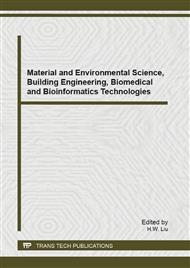[1]
Mei Guang-quan. Harmfulness and Treatment of Heavy Metal Waste Water [J]. Studies of Trace Elements and Health, Vol. 21 (2004), Issue 4.
Google Scholar
[2]
Zou Zhaohua, He Sufang, Han Caiyun, Zhang Liuyi, Luo Yongming. Progress of Heavymetal Liquid Waste Progressing Technique [J]. Technology of Water Treatment, Vol. 36 (2010), Issue 6.
Google Scholar
[3]
F.J. Alguacil, F.A. Lopez, I. Garcia-Diaz. Copper removal from acidic wastewaters using 2-hydroxy-5-nonylbenzaldehyde oxime as ionophore in pseudo-emulsion membrane with strip dispersion (PEMSD) technology [J]. Journal of Industrial and Engineering Chemistry, Vol. 18 (2012).
DOI: 10.1016/j.jiec.2011.11.034
Google Scholar
[4]
Merve Zeyrek Ongun, Kadriye Ertekin, Mustafa Gocmenturk, Yavuz Ergun, Aslıhan Suslu. Copper ion sensing with fluorescent electrospun nanofibers [J]. Spectrochimica Acta Part A: Molecular and Biomolecular Spectroscopy, Vol. 90 (2012).
DOI: 10.1016/j.saa.2012.01.042
Google Scholar
[5]
Zhang Yongfeng, Xu Zhenliang. Latest developments of the treatment of heavy metal wastewater [J]. Industrial Water Treatment, Vol. 23 (2003), Issue 6.
Google Scholar
[6]
Liang Shuai, Yan Dong-yun, Xu Shao-hui. Review on Microbiological and Botanical Treatment Technology for Heavy Metal Wastewater [J]. Environmental Science & Technology, Vol. 32 (2009), Issue 11.
Google Scholar
[7]
B. Stephen Inbaraj, J.S. Wang, J.F. Lu, F.Y. Siao, B.H. Chen. Adsorption of toxic mercury(II) by an extracellular biopolymer poly(γ-glutamic acid) [J] Bioresource Technology, Volume 100 (2009), Pages 200–207.
DOI: 10.1016/j.biortech.2008.05.014
Google Scholar
[8]
K.F. Lam, H. Kassab, M. Pera-Titus, K.L. Yeung, B. Albela, L. Bonneviot. MCM-41 LUS: alumina tubular membranes for metal separation in aqueous solution [J]. Journal of Physical Chemistry C, Vol. 115 (2011), Issue 1, Pages 176–187.
DOI: 10.1021/jp1065874
Google Scholar
[9]
Du Jun, Zhou Kun, Tao Changyuan. Advances in supported liquid membranes [J]. Chemical Research and Application, Vol. 16 (2004), Pages 160-164.
Google Scholar
[10]
Gu Zhongmao. State of the art and recent progress of liquid membrane separation processes [J]. Membrane Science and Technology, Vol. 23 (2003), Pages 214-223.
Google Scholar
[11]
Gerardo León, Guillermo Martínez, María Amelia Guzmán, Juan Ignacio Moreno, Beatriz Miguel, José Antonio Fernández-López. Increasing stability and transport efficiency of supported liquid membranes through a novel ultrasound-assisted preparation method. Its application to cobalt(II) removal [J]. Ultrasonics Sonochemistry, Vol. 20 (2013).
DOI: 10.1016/j.ultsonch.2012.10.002
Google Scholar


